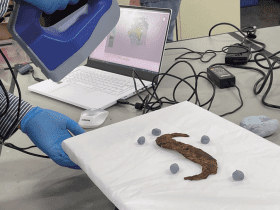Natural Heritage Division
JUNG Seungho
Cenozoic Fossil Wood Discovered
In 2009, a 10.2-meter-tall and 0.9 to 1.3-meter- wide tree fossil was uncovered during a road construction excavation in Pohang, Korea. This remarkable discovery, the largest Cenozoic fossil wood found in Korea, showcases exceptionally well- preserved body and knot structures. Identified for its significant academic and educational value in shedding light on the sedimentary environment and vegetation of the Korean Peninsula 20 million years ago, it subsequently received official recognition. In January 2023, it was designated as a national heritage(natural monument), bearing the name “Cenozoic Fossil Wood from Geumgwang-ri, Pohang.”
Conservation and Management of Fossil Wood
Since 2011, when wood fossil was placed under state custody, the NRICH has assumed responsibility for its conservation and management. Following a three-year urgent conservation process involving debris removal, fragment cementation, and chemical treatment, the wood fossil is meticulously stored within the storage facilities of the Natural Heritage Center.
Significance of Natural Monument Designation
The Cenozoic wood fossil from Geumgwang-ri, Pohang marks Korea’s inaugural designation of an individual tree fossil. By expanding beyond the prevailing focus on dinosaur-related fossil sites and bolstering the conservation of specimen- based natural monuments, this achievement offers a chance to enhance the diversity and future value of geological heritage.








